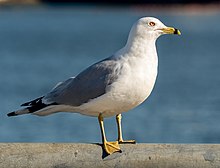The ring-billed gull (Larus delawarensis) is a medium-sized gull. The genus name is from Latin Larus which appears to have referred to a gull or other large seabird. The specific delawarensis refers to the Delaware River.[2]
| Ring-billed gull | |
|---|---|

| |
| Breeding adult in New York | |
| Scientific classification | |
| Domain: | Eukaryota |
| Kingdom: | Animalia |
| Phylum: | Chordata |
| Class: | Aves |
| Order: | Charadriiformes |
| Family: | Laridae |
| Genus: | Larus |
| Species: | L. delawarensis
|
| Binomial name | |
| Larus delawarensis Ord, 1815
| |

| |
Description
editMeasurements:[3]
- Length: 16.9–21.3 in (43–54 cm)
- Weight: 10.6–24.7 oz (300–700 g)
- Wingspan: 41.3–46.1 in (105–117 cm)
The head, neck and underparts are white; the relatively short bill is yellow with a dark ring; the back and wings are silver gray; and the legs are yellow. The eyes are yellow with red rims. This gull takes three years to reach its breeding plumage; its appearance changes with each fall moult.[4]
The average lifespan of an individual that reaches adulthood is 10.9 years[4] The oldest ring-billed gull on record was observed in Cleveland in 2021, still alive at the age of 28 years.[5]
Distribution and habitat
editThe ring-billed gulls' breeding habitat is near lakes, rivers, or the coast in Canada and the northern United States. They nest colonially on the ground, often on islands. This bird tends to be faithful to its nesting site, if not its mate, from year to year.
The ring-billed gull is a familiar sight in American and Canadian parking lots, where it can regularly be found congregating in large numbers.[6][7] In some areas, it is displacing less aggressive birds such as the common tern.
They are migratory and most move south to the Gulf of Mexico and the Atlantic and Pacific coasts of North America, and the Great Lakes.
Vagrancy
editThis gull is a regular wanderer to western Europe. In Ireland and Great Britain it is no longer classed as a rarity, with several birds regularly wintering in those countries.
Diet
editRing-billed gulls forage in flight or pick up objects while swimming, walking or wading. They also steal food from other birds and frequently scavenge. They are omnivorous; their diet may include insects, fish, grain, eggs, earthworms and rodents.[8] These birds are opportunistic and have adapted well to taking food when discarded or even left unattended by people. It is regarded as a pest by many beach-goers because of its willingness to steal unguarded food on crowded beaches. The birds congregate at beaches, marinas, docks and parks where people will hand feed them.
The gull's natural predators are rats, foxes, dogs, cats, raccoons, coyotes, eagles, hawks (although they have been seen in pairs chasing hawks), and owls.
Status
editIn the late 19th century, the ring-billed gull was hunted for its plumage. Its population has since rebounded and it is probably the most common gull in North America. The population was estimated in 2006 as 2.55 million birds.[9]
References
edit- ^ BirdLife International (2018). "Larus delawarensis". IUCN Red List of Threatened Species. 2018: e.T22694317A132541912. doi:10.2305/IUCN.UK.2018-2.RLTS.T22694317A132541912.en. Retrieved 18 November 2021.
- ^ Jobling, James A (2010). The Helm Dictionary of Scientific Bird Names. London: Christopher Helm. pp. 132, 219. ISBN 978-1-4081-2501-4.
- ^ "Ring-billed Gull Identification, All About Birds, Cornell Lab of Ornithology". www.allaboutbirds.org. Retrieved 2020-09-25.
- ^ a b "The IUCN Red List of Threatened Species". IUCN Red List of Threatened Species. Retrieved 2019-12-21.
- ^ Mandelbaum, Ryan F. (23 March 2021). "Oldest Ring-billed Gull on Record Discovered by Cleveland Birder". National Audubon Society. Retrieved 11 April 2021.
- ^ "Ring-billed Gull". Common Birds of New England. Retrieved 16 March 2014.
- ^ Ray, C. Claiborne (30 September 2013). "Why do Sea Gulls Like Parking Lots?". New York Times. Retrieved 16 March 2014.
- ^ "Ring-billed Gull". Audubon. Retrieved 2024-04-22.
- ^ Pollet, I. L., D. Shutler, J. W. Chardine, and J. P. Ryder (2020). Ring-billed Gull (Larus delawarensis), version 1.0. In Birds of the World (A. F. Poole, Editor). Cornell Lab of Ornithology, Ithaca, NY, USA. https://doi.org/10.2173/bow.ribgul.01
External links
edit- BirdLife species factsheet for Larus delawarensis
- "Larus delawarensis". Avibase.
- "Ring-billed gull media". Internet Bird Collection.
- Ring-billed gull photo gallery at VIREO (Drexel University)
- Interactive range map of Larus delawarensis at IUCN Red List maps
- Ring-billed gull Species Account – Cornell Lab of Ornithology
- Ring-billed gull - Larus delawarensis - USGS Patuxent Bird Identification InfoCenter
- Audio recordings of Ring-billed gull on Xeno-canto.
- Larus delawarensis in Field Guide: Birds of the World on Flickr
